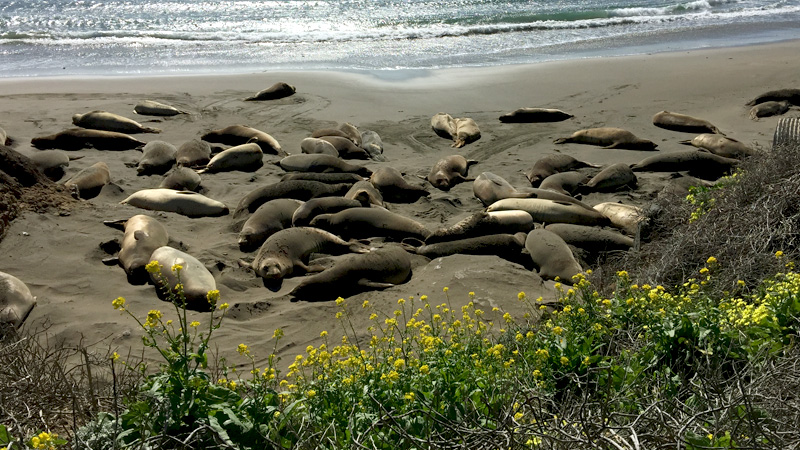
After hiking through Limekiln State Park, hiking to Salmon Creek Falls, and enjoying lunch at Ragged Point, we drove down to San Simeon for our last family adventure in Big Sur — visiting the Piedras Blancas Elephant Seal Rookery.
We always get a kick out of seeing the sea lions lounging around Pier 39 in San Francisco and the sea lions and sea otters in Monterey Bay, so when I read about the Elephant Seal Rookery, I wanted to take the kids to check it out.
For the last leg of our spring break trip, we were staying at the Big Sur River Inn at the top of Big Sur and weren’t sure we’d make it far enough south to visit the rookery, but luckily, after making it all the way to Ragged Point, Piedras Blancas was only a few more miles down the Pacific Coast Highway.
The Elephant Seal Rookery encompasses six miles of protected coastline where the elephant seals come for pupping and mating season, and to molt and grow new fur. This year alone 5,700 elephant seal babies were born along the coastline. To protect the elephant seals, a boardwalk and viewing areas are available with docents who can answer questions and tell you about the animals. Viewing areas are open every day and there are no fees or reservations required.
Luckily we visited the rookery in March at the tail end of the peak season, and there were hundreds of huge elephant seals and their pups lounging all over the beaches.
The northern elephant seal is the largest seal in the northern hemisphere and the second largest seal in the world. Large males are 14 to 16 feet in length and weigh 3,000 to 5,000 pounds. Adult females are 9 to 12 feet in length and weigh between 900 and 1800 pounds. Pups are 3 to 4 feet long and weigh 60 to 80 pounds at birth.
According to the Friends Of The Elephant Seal website, the number of seals at the rookery peaks three times during the year:
- In late January when most births have occurred (winter is pupping and mating season)
- Around the first of May at the peak of the juvenile/adult female molt (late spring/early summer)
- In late October during the fall or juvenile haul-out (fall)
Piedras Blancas Elephant Seal History
When looking at the beaches north and south of Point Piedras Blancas covered in big, fat, sun bathing elephant seals flinging sand on themselves to stay cool, it’s easy to wonder where they all came from and why they choose these beaches.
After talking to a docent at the viewing area and doing some research online, I found some quick facts:
- In 1990, elephant seals arrived on the beaches just south of the Piedras Blancas Lighthouse.
- By the spring of 1991, almost 400 seals arrived to molt.
- In February, 1992 the first elephant seal pup was born at Piedras Blancas.
- In 1993, about 50 pups were born.
- In 1995, 600 pups were born.
- By 1996 the number of pups soared to nearly 1000 and the colony stretched southward and northward to beaches adjacent to Highway 1.
- Most elephant seals return to the beaches where they were born, so the population continues to grow every year.
- In 2014-2015, more than 23,000 elephant seals arrived along the six mile stretch of coastline.
While elephant seals can usually be seen at the beach all year long, the best times to visit are during late January, April, and October.
Other Nearby Big Sur Attractions
The Elephant Seal Rookery sits at the far, southern end of California’s Big Sur Coastline. It is the first of many family-friendly activities scattered throughout Big Sur, such as hiking to panoramic scenic viewpoints, exploring serene redwood forests, picnicking on the coast, collecting shells, Jade, and rocks along pristine beaches, visiting awe-inspiring waterfalls, and trying new restaurants.
When traveling north on Highway 1 from the Elephant Seal Rookery, it is approximately:
- 17 miles to Ragged Point Inn and Plaza
- 21 miles to the Salmon Creek Falls Trailhead
- 30 miles to the Willow Creek Picnic Ground
- 32 miles to Sand Dollar Beach
- 33 mile to Jade Cove
- 40 miles to Limekiln State Park
- 54 miles to Julia Pfeiffer Burns State Park
- 63 miles to the Pfeiffer Beach turnouff (Sycamore Canyon Road)
- 64 miles to Pfeiffer Big Sur State Park
- 67 miles to the Big Sur River Inn
- 69 miles to Andrew Molera State Park
- 73 miles to Point Sur State Historic Park
- 81 miles to Garrapata State Park
- 88 miles to Point Lobos State Natural Reserve



